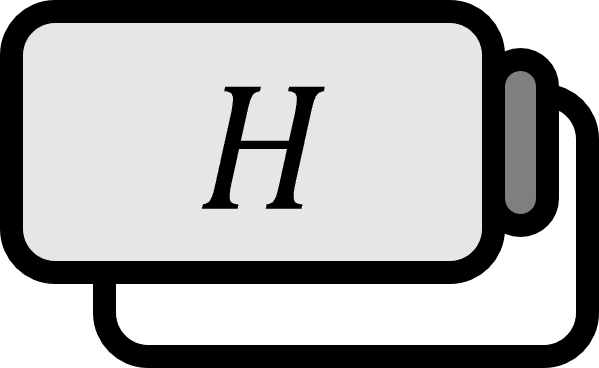Properties of Adjoint Operators
Theorem1
Let’s call $H,K$ a Hilbert space. For a bounded linear operator $T : K \to H$, $T^{\ast} : H \to K$ is called the adjoint operator of $T$ if it satisfies the following.
$$ \left\langle T \textbf{v} , \textbf{w} \right\rangle_{H} = \left\langle \textbf{v} , T^{\ast} \textbf{w} \right\rangle_{K},\quad \forall \textbf{v} \in K $$ The adjoint operator has the following properties.
(a) $T^{\ast}$ is linear and bounded.
(b) $\left( T^{\ast} \right)^{\ast} = T$
(c) $\left\| T^{\ast} \right\| = \left\| T \right\| $
Proof
(a)
Part 1. $T^{\ast}$ is linear
According to the definition,
$$ T^{\ast}( \alpha \mathbf{w}+\beta \mathbf{u} )=\alpha T^{\ast}(\mathbf{w})+\beta T^{\ast}(\mathbf{u}) $$
we need to show that. By the definition of $T^{\ast}$ and the inner product, for $\mathbf{v}\in K$, the following holds.
$$ \begin{align*} \left\langle \mathbf{v}, T^{\ast}(\alpha \mathbf{w}+ \beta \mathbf{u}) \right\rangle_{K} =&\ \left\langle T\mathbf{v},\alpha \mathbf{w} + \beta \mathbf{u} \right\rangle_{H} \\ =&\ \overline{\alpha}\left\langle T\mathbf{v},\mathbf{w} \right\rangle_{H} +\overline{\beta} \left\langle T\mathbf{v}, \mathbf{u} \right\rangle_{H} \\ =&\ \overline{\alpha}\left\langle \mathbf{v}, T^{\ast}\mathbf{w} \right\rangle_{K} +\overline{\beta} \left\langle \mathbf{v}, T^{\ast} \mathbf{u} \right\rangle_{K} \\ =&\ \left\langle \mathbf{v}, \alpha T^{\ast} \mathbf{w}+\beta T^{\ast} \mathbf{u} \right\rangle_{K} \end{align*} $$
$$ T^{\ast}( \alpha \mathbf{w}+\beta \mathbf{u} )=\alpha T^{\ast}(\mathbf{w})+\beta T^{\ast}(\mathbf{u}) $$
Part 2. $T^{\ast}$ is bounded
According to the definition,
$$ \left\| T^{\ast}\mathbf{w} \right\| \le C \left\| \mathbf{w} \right\|,\quad \forall \mathbf{w}\in H $$
we need to show that there exists a constant $C$ that satisfies it. By the relationship between the inner product and the norm, the following holds.
$$ \left\| T^{\ast}\mathbf{w} \right\| = \sup \limits_{\substack{\mathbf{v}\in K \\ \left\| \mathbf{v} \right\|=1 }} \left| \left\langle \mathbf{v},T^{\ast}\mathbf{w} \right\rangle_{K} \right| $$
Thus, by the definition of $T^{\ast}$ and the Cauchy-Schwarz inequality, the following holds.
$$ \begin{align*} \left\| T^{\ast}\mathbf{w} \right\| =&\ \sup \limits_{\substack{\mathbf{v}\in K \\ \left\| \mathbf{v} \right\|=1 }} \left| \left\langle \mathbf{v},T^{\ast}\mathbf{w} \right\rangle_{K} \right| \\ =&\ \sup \limits_{\substack{\mathbf{v}\in K \\ \left\| \mathbf{v} \right\|=1 }} \left| \left\langle T\mathbf{v},\mathbf{w} \right\rangle_{H} \right| \\ \le& \sup \limits_{\substack{\mathbf{v}\in K \\ \left\| \mathbf{v} \right\|=1 }} \left\| T\mathbf{v} \right\| \left\| \mathbf{w} \right\| \end{align*} $$
Since $T$ is bounded, $\left\| T\mathbf{v} \right\|\le \left\| T \right\| \left\| \mathbf{v} \right\|$ holds. Therefore,
$$ \begin{align*} \left\| T^{\ast}\mathbf{w} \right\| \le& \sup \limits_{\substack{\mathbf{v}\in K \\ \left\| \mathbf{v} \right\|=1 }} \left\| T\mathbf{v} \right\| \left\| \mathbf{w} \right\| \\ \le& \sup \limits_{\substack{\mathbf{v}\in K \\ \left\| \mathbf{v} \right\|=1 }} \left\| T \right\| \left\| \mathbf{v} \right\| \left\| \mathbf{w} \right\| \\ \le& \left\| T \right\| \left\| \mathbf{w} \right\| \end{align*} $$
$T^{\ast}$ is bounded.
■
(b)
It can be simply shown by the definition of $T^{\ast}$ and the inner product.
$$ \begin{align*} \left\langle T\mathbf{v},\mathbf{w} \right\rangle_{H} =&\ \left\langle \mathbf{v},T^{\ast}\mathbf{w} \right\rangle_{K} \\ =&\ \overline{\left\langle T^{\ast}\mathbf{w},\mathbf{v} \right\rangle_{K}} \\ =&\ \overline{\left\langle \mathbf{w},(T^{\ast})^{\ast}\mathbf{v} \right\rangle_{K}} \\ =&\ \left\langle (T^{\ast})^{\ast}\mathbf{v},\mathbf{w} \right\rangle_{K} \end{align*} $$
As this holds for all $\mathbf{w}$, the logic from Part 1. applies here as well.
$$ T\mathbf{v}=(T^{\ast})^{\ast}\mathbf{v}\implies T=(T^{\ast})^{\ast} $$
■
(c)
From the proof of (a), we obtained $\left\| T^{\ast} \right\| \le \left\| T \right\|$. In the same way, we can obtain the inequality in the opposite direction.
$$ \begin{align*} \left\| T\mathbf{v} \right\| =&\ \sup \limits_{\substack{\mathbf{w}\in H \\ \left\| \mathbf{w} \right\|=1 }} \left| \left\langle T\mathbf{v},\mathbf{w} \right\rangle_{H} \right| \\ =&\ \sup \limits_{\substack{\mathbf{w}\in H \\ \left\| \mathbf{w} \right\|=1 }} \left| \left\langle \mathbf{v},T^{\ast}\mathbf{w} \right\rangle_{K} \right| \\ \le& \sup \limits_{\substack{\mathbf{w}\in H \\ \left\| \mathbf{w} \right\|=1 }} \left\| \mathbf{v} \right\| \left\| T^{\ast}\mathbf{w} \right\| \\ \le& \sup \limits_{\substack{\mathbf{w}\in H \\ \left\| \mathbf{w} \right\|=1 }} \left\| \mathbf{v} \right\| \left\| T^{\ast} \right\| \left\| \mathbf{w} \right\| \\ \le& \left\| T^{\ast} \right\| \left\| \mathbf{v} \right\| \end{align*} $$
Therefore, since $\left\| T^{} \right\|\le \left\| T^{\ast} \right\|$ holds,
$$ \left\| T \right\| = \left\| T^{\ast} \right\| $$
■
Ole Christensen, Functions, Spaces, and Expansions: Mathematical Tools in Physics and Engineering (2010), p72 ↩︎
